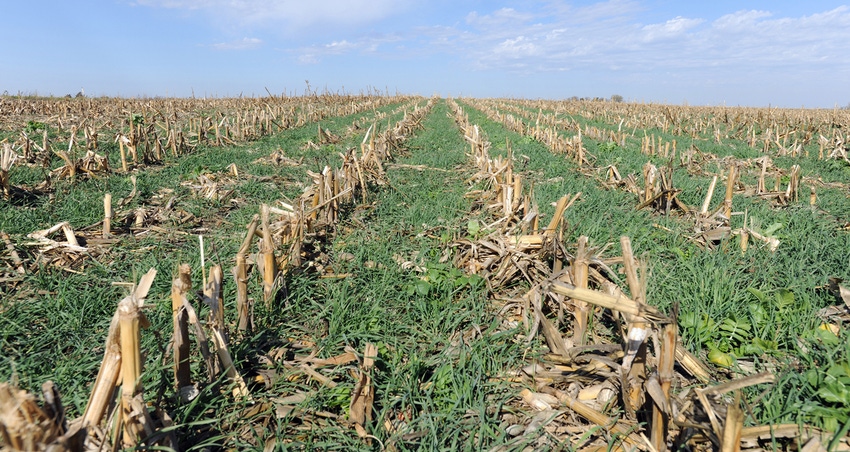January 17, 2020

When Editor Rod Swoboda asked me to write an article on the conservation contributions of my son Pete (especially in cover crops), my first reaction was, “No way, Jose!” But Rod persisted.
Then it dawned on me this is not a story about my son, but an article about Pete Crew, an accomplished leader in soil and water conservation here in northwest Iowa, where he is regarded as the cover crop guru.
Pete grew up differently from most farm kids in that he missed a highlight of most farm boys’ early upbringing, which was the day Dad turned you loose driving the tractor preparing ground for planting. I can go to the very spot where my dad got off the seat of the B John Deere and said, “Keep her in second. Don’t hit the fence, and make sure you cover every spot.”
He should have added, “Don’t turn too short,” because we were using a spring tooth harrow, which had two cables from each end going to the tractor’s drawbar — meaning taking too short of a turn and the tractor tire would be “wearing the spring tooth harrow!”
I installed my first grassed-back sloped tile intake terrace when Pete was 7-years-old (before no-till). I was pleasantly surprised when I discovered his “mini” version of my conservation structure in the grove a couple of days later. Using old pieces of water pipe, baling wire, Sakrete from Dad’s machine shed and a lot of ingenuity, Pete had perfectly replicated the surface intake of my grassed-back terraces.
Graduating from Iowa State University in 1993, with a major in agronomy and a minor in entomology, Pete entered the workforce as an agronomist with Crestland Co-op, which was at that time among the largest co-ops in Iowa. After a couple of years, he was offered a job by Craig Struve of CS Agro at Calumet in northwest Iowa, promising him the opportunity to open a subsidiary office in a private elevator at Rossie, closer to our farm in Clay County.
Providing service from day one
Pete liked working with and helping his farmer-customers. An example was the very first influx of soybean aphids to hit northwest Iowa. At that time, the recommended threshold for spraying was 2,000 aphids per plant, but Pete felt the conditions were set up for an explosion and told his customers to spray when they found aphids — forget the thresholds. Fortunately, those who followed his advice were rewarded anywhere from 10 to 20 bushels per acre in additional bushels compared to farmers who didn’t spray or those who waited for the 2,000 per plant threshold.
Many of Pete’s customers urged him to start his own agronomy business and pledged their support. Their encouragement fueled his personal desire, and in 2002 he started out establishing Spencer Agronomy Services (SAS), without even a machine shed as his headquarters. With major league borrowing (antithesis to his father), he built a complete one-stop service facility, including the ability for his customers to back in their sprayers and emerge within minutes with a full load ready to be sprayed. The present-day complex is at Ruthven, Iowa.
One of the first purchases made by SAS was a strip-till machine. Why? ”Dad, I’ve watched you over the years struggle with no-till into soybean stubble experimenting with various row cleaners. Yes, you’ve been successful because your goal is continuous no-till. No exceptions! However, once you plant into this strip where the soil is always warmer and drier, I can guarantee you’ll be pleased.”
Of course, he was right! Previously I would spend a lot of time jumping on and off the tractor constantly checking and changing planting depths before giving up and settling for a depth that was sometimes too shallow and sometimes too deep. The first time I pulled into a field that had been strip-tilled, with my six-row no-till planter, I was amazed because every time I would check planting depth, every row was the same. The seed was all placed at the same uniform depth. Only problem was I needed to be able to drive “straight” because getting off the strip by a couple 3 inches didn’t work!
No-till, strip till, cover crops
Pete’s planting advice was always use strip till before planting corn, demonstrating that strip till could work even in no-till continuous corn. In fact, he demonstrated less allelopathic effect on the emerging corn plants because most of the cornstalk crop residue remained on the surface rather than buried with tillage. His advice on soybeans was always to plant directly into the cornstalks because soybean emergence was independent of tillage. To those customers who felt their planters were not capable of planting into crop residue, Pete was first in the area to provide precision planting advice and to provide the capability to incorporate the benefits of air pressure downforce with SAS’s ability to do the planter modifications in their shop.
 GOOD ADVICE: Pete Crew’s planting advice was always use strip till before planting corn, demonstrating that strip till could work even in no-till continuous corn.
GOOD ADVICE: Pete Crew’s planting advice was always use strip till before planting corn, demonstrating that strip till could work even in no-till continuous corn.

SAS has a lot of customers farming thousands of acres and the number of farmers buying into no-till because of Pete is amazing. This area (northern Iowa) is tillage country, but now you can drive 3 or 4 miles at a stretch with no visible sign of tillage.
It wasn’t until about 2009 I finally understood his dedication to soil and water conservation. I was combining soybeans (I had long ago turned every other decision over to SAS) when I started noticing an undergrowth of green in the south half of the field. I quickly dialed Pete and asked him if he’d forgotten to spray the south half. He chuckled and said he forgot to tell me he flew on some cereal rye as a cover crop in late August.
That was the start of his ongoing effort to promote cover crops with extensive research, including almost every conceivable combination of seed and methods of application. The best option for northwest Iowa is cereal rye aerially seeded in the latter part of August into standing corn and soybeans.
Do cover crops pay? Perhaps not always short term (although side-by-side tests the past couple years has shown a significant yield increase in soybeans), but certainly when cover crops are coupled with no tillage, the long-term soil health benefits multiply rapidly.
Truly sustainable farming
In October 2018, Pete’s second son suffered from sudden cardiac arrest, but fortunately CPR was started immediately. He survived with no long-term effects, but Pete and his wife agreed the stress of running a 12-employee business was too much with the family’s health of primary concern, so they sold the business.
Are Pete’s days as a leading conservationist over? No way. He and a partner started VisAg Solutions, looking into making crops grown without tillage and protected with cover crops a marketing tool for companies to concentrate on as truly sustainable agriculture and best for the environment. Carbon sequestration and limiting greenhouse gas emissions is of vital importance.
By verifying that you are using practices that control erosion, protect water quality, and improve soil health and air quality, this message can be carried on food labels and used in other ways to reach consumers. Because “organic” now permeates every aspect of the national food industry, the VisAg approach will be a critical test. Stay tuned! For information visit visagsolutions.com/vissg-advantage.php.
Editor’s note: Jerry Crew is a longtime 100% no-till farmer near Webb in northwest Iowa. He has served as a Soil Conservation District Commissioner in Clay County for many years. He received Iowa’s Outstanding Soil Conservation District Commissioner Award, sponsored by Wallaces Farmer, in 1992 and 2004.
You May Also Like




